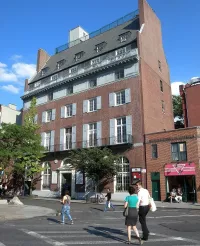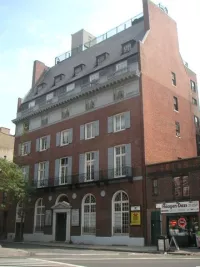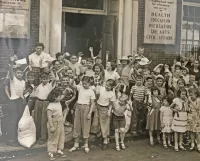Share what you know,
and discover more.
Share what you know,
and discover more.
Dec 28, 2020

-

- David Decker
Greenwich House (former home of Amelia Earhart)
A Village institution, Greenwich House was founded in 1902 at the height of the settlement house movement. It was originally known as the Cooperative Social Settlement Society of the City of New York and remains one of the Village's most active forces for improving the lives of residents. Many people have worked for and benefitted from Greenwich House, but one of its most famous staff members was famed aviatrix Amelia Earhart, who worked and lived there in the late 1920s. In the late 1800s and early 1900s, as the country's cities underwent rapid changes brought on by industrialization and immigration, reform-minded women established settlement houses, which were created to help alleviate poverty in slum neighborhoods. In 1902, Greenwich House was founded by Mary Kingsbury Simkhovitch. Like other settlement houses, Greenwich House provided a wide assortment of programs for the community that reflected the views of Simkhovitch, who envisioned the house as an integral part of the community. Greenwich House expanded quickly in the early 1900s, acquiring several other buildings in the neighborhood in the process. It established music and pottery schools, programs which are still extant and housed in historic buildings. It also provided infant and child care programs and investigated the high rates of infant mortality in the Village. In addition to pottery classes, Greenwich House offered numerous art programs, which was likely due to the influence of Gertrude Payne Whitney, who was a member of the board and later founded the Whitney Museum. Whitney was also instrumental in getting artists to paint murals in the main building's interior. Like most settlement houses, Greenwich House was staffed by social workers and middle-class reformers, all of whom were young women. Most of these women have undoubtedly been lost to history, but in 1927, Greenwich House welcomed famed aviatrix Amelia Earhart as a volunteer and resident. Earhart had already worked as a social worker in Boston, but her flying career often got in the way of her work there. After moving to Greenwich Village, she approached Greenwich House about continuing her social work there and was offered a staff position and a room. She lived in Barrow Street building until 1929, and though people in the community almost certainly knew who she was, she lived, reportedly, like a regular citizen. Greenwich House remains a vital part of the Village and still maintains many of the programs it began more than a century ago. It offers senior services, health services, and maintains a youth community center, in addition to its original offerings.
Greenwich House (former home of Amelia Earhart)
A Village institution, Greenwich House was founded in 1902 at the height of the settlement house movement. It was originally known as the Cooperative Social Settlement Society of the City of New York and remains one of the Village's most active forces for improving the lives of residents. Many people have worked for and benefitted from Greenwich House, but one of its most famous staff members was famed aviatrix Amelia Earhart, who worked and lived there in the late 1920s. In the late 1800s and early 1900s, as the country's cities underwent rapid changes brought on by industrialization and immigration, reform-minded women established settlement houses, which were created to help alleviate poverty in slum neighborhoods. In 1902, Greenwich House was founded by Mary Kingsbury Simkhovitch. Like other settlement houses, Greenwich House provided a wide assortment of programs for the community that reflected the views of Simkhovitch, who envisioned the house as an integral part of the community. Greenwich House expanded quickly in the early 1900s, acquiring several other buildings in the neighborhood in the process. It established music and pottery schools, programs which are still extant and housed in historic buildings. It also provided infant and child care programs and investigated the high rates of infant mortality in the Village. In addition to pottery classes, Greenwich House offered numerous art programs, which was likely due to the influence of Gertrude Payne Whitney, who was a member of the board and later founded the Whitney Museum. Whitney was also instrumental in getting artists to paint murals in the main building's interior. Like most settlement houses, Greenwich House was staffed by social workers and middle-class reformers, all of whom were young women. Most of these women have undoubtedly been lost to history, but in 1927, Greenwich House welcomed famed aviatrix Amelia Earhart as a volunteer and resident. Earhart had already worked as a social worker in Boston, but her flying career often got in the way of her work there. After moving to Greenwich Village, she approached Greenwich House about continuing her social work there and was offered a staff position and a room. She lived in Barrow Street building until 1929, and though people in the community almost certainly knew who she was, she lived, reportedly, like a regular citizen. Greenwich House remains a vital part of the Village and still maintains many of the programs it began more than a century ago. It offers senior services, health services, and maintains a youth community center, in addition to its original offerings.
Dec 28, 2020
Greenwich House (former home of Amelia Earhart)
A Village institution, Greenwich House was founded in 1902 at the height of the settlement house movement. It was originally known as the Cooperative Social Settlement Society of the City of New York and remains one of the Village's most active forces for improving the lives of residents. Many people have worked for and benefitted from Greenwich House, but one of its most famous staff members was famed aviatrix Amelia Earhart, who worked and lived there in the late 1920s.In the late 1800s and early 1900s, as the country's cities underwent rapid changes brought on by industrialization and immigration, reform-minded women established settlement houses, which were created to help alleviate poverty in slum neighborhoods. In 1902, Greenwich House was founded by Mary Kingsbury Simkhovitch. Like other settlement houses, Greenwich House provided a wide assortment of programs for the community that reflected the views of Simkhovitch, who envisioned the house as an integral part of the community.
Greenwich House expanded quickly in the early 1900s, acquiring several other buildings in the neighborhood in the process. It established music and pottery schools, programs which are still extant and housed in historic buildings. It also provided infant and child care programs and investigated the high rates of infant mortality in the Village. In addition to pottery classes, Greenwich House offered numerous art programs, which was likely due to the influence of Gertrude Payne Whitney, who was a member of the board and later founded the Whitney Museum. Whitney was also instrumental in getting artists to paint murals in the main building's interior.
Like most settlement houses, Greenwich House was staffed by social workers and middle-class reformers, all of whom were young women. Most of these women have undoubtedly been lost to history, but in 1927, Greenwich House welcomed famed aviatrix Amelia Earhart as a volunteer and resident. Earhart had already worked as a social worker in Boston, but her flying career often got in the way of her work there. After moving to Greenwich Village, she approached Greenwich House about continuing her social work there and was offered a staff position and a room. She lived in Barrow Street building until 1929, and though people in the community almost certainly knew who she was, she lived, reportedly, like a regular citizen.
Greenwich House remains a vital part of the Village and still maintains many of the programs it began more than a century ago. It offers senior services, health services, and maintains a youth community center, in addition to its original offerings.
Posted Date
Jul 25, 2023
Historical Record Date
Dec 28, 2020
Source Name
Clio - Written by Rebecca Woodham
Source Website
Delete Story
Are you sure you want to delete this story?
Aug 03, 2010
Aug 03, 2010

-

- David Decker
Greenwich House
Greenwich House was founded on Thanksgiving Day in 1902 by city planner and social worker Mary K. Simkhovitch in a building at 26 Jones Street in Manhattan's West Village. Its original focus was to help New York's growing immigrant population adapt to life in their new home. Early supporters who joined her on opening day included social reformers Jacob Riis, Felix Adler and Carl Shurz. Greenwich Village was a mixed area at the time. Italian immigrants began crowding out the existing Irish population. Many homes along the maze of streets and alleys lacked running water. There was a high infant death rate and poor education. Early programs sought to relieve congestion and improve living conditions, which included founding the Greenwich Village Improvement Society, forerunner to the Greenwich Village Association and first neighborhood association of its kind in the United States, and publishing the Tenant's Rights Manual, the first ever of its kind in the nation. Recognizing a need for recreational and skills training among Village residents, Greenwich House established Greenwich House Music School at 46 Barrow in 1905 followed by the Handicraft School, the precursor to Greenwich House Pottery, in 1909. By 1917 the organization's programs were becoming overcrowded in its Jones Street buildings. Thanks to a gift from Gertrude Vanderbilt Whitney, Greenwich House was able to hire architects Delano and Aldrich to design its current Federalist building at 27 Barrow Street. The new building, complete with a gym, running track, theater, and rooftop playground provided Greenwich House the space to establish new programs like a nursery school and children's theater program. Greenwich House soon needed more space. The old Handicraft School building was rebuilt as Greenwich House Pottery in 1928, enabling it to become an international center for ceramics. The Metropolitan Museum of Art purchased two pieces from the Pottery in 1939. In 1942 Greenwich House continued to add more services with New York City's first after-school program followed closely by a senior center. By the 1980s Greenwich House offered a mix of social service and arts education programs. In the late 1980s, Greenwich House played a central role in the AIDS crisis in the West Village neighborhood, one of the city's original gay villages. In 1987 Greenwich House opened the AIDS Mental Health Project followed by the HIV Primary Medical Care Project. Today, the organization continues to host a long-term HIV survivors support group. Also in 1987, Greenwich House founded the Children's Safety Project, the only program in the city dedicated to treating young victims of abuse. The Children's Safety Project was founded after a group of concerned neighbors came together after the killing of a local Village child, nine-year-old Lisa Steinberg. Today Greenwich House provides art education, senior service and behavioral health programs including an after-school, summer arts camp, nursery school, senior centers and senior health clinic, substance abuse clinics and a program for children who have suffered from abuse. Locations and facilities Greenwich House's main facilities are located in Greenwich Village, including its main building at 27 Barrow Street, Pottery at 16 Jones Street and Music School at 46 Barrow Street. Greenwich House also rents space for programs, primarily senior and behavioral health programs, including at a nearby church, Our Lady of Pompeii; at a former convent located on Washington Square Park North. Greenwich House's main building was built between 1916 and 1917, funded by board members including Gertrude Vanderbilt Whitney and Anna Woershoffer. The Flemish-bond building was designed in the neo-federal style by architects Delano and Aldrich.[9] The building was considered an example of refined American design, complete with a mural by Arthur Crisp, intended to inspire immigrants new to the country. The seven-story building contains a professional theater, currently the home of Ars Nova and previously home to Soho Rep and the Barrow Street Theatre, a gym with running track, commercial kitchen, medical offices and a rooftop playground among other facilities. The building was built with a shaft for an elevator, but no actual elevator, as the new technology was too expensive at the time. Greenwich House Pottery is located at 16 Jones Street. The current building was built in 1928, also designed by Delano and Aldrich. The building is notable for containing the only gas kilns in Manhattan which are grandfathered despite no longer being allowed in new construction. It is also the home of the Jane Hartsook Gallery. Greenwich House Music School, located at 46 Barrow Street composes two out of a row of six brick row homes. The homes were originally designed in the Italianate style by Smith Woodruff in 1851. The two Music School homes were combined on the interior and now comprise the 100 seat Renee Weiler Concert Hall as well as sound proof practice rooms. Greenwich House's rented space in the basement of Our Lady of Pompeii Catholic Church also received notoriety. In 2015, after more than thirty years in the space, the pastor of the church attempted to kick the senior center out, hoping to lease the space for more money to movie crews wanting to film in the Village. After months of negotiations, including elected officials and Cardinal Timothy Dolan, weighing in, the church agreed to a new revised lease allowing the center to remain.
Greenwich House
Greenwich House was founded on Thanksgiving Day in 1902 by city planner and social worker Mary K. Simkhovitch in a building at 26 Jones Street in Manhattan's West Village. Its original focus was to help New York's growing immigrant population adapt to life in their new home. Early supporters who joined her on opening day included social reformers Jacob Riis, Felix Adler and Carl Shurz. Greenwich Village was a mixed area at the time. Italian immigrants began crowding out the existing Irish population. Many homes along the maze of streets and alleys lacked running water. There was a high infant death rate and poor education. Early programs sought to relieve congestion and improve living conditions, which included founding the Greenwich Village Improvement Society, forerunner to the Greenwich Village Association and first neighborhood association of its kind in the United States, and publishing the Tenant's Rights Manual, the first ever of its kind in the nation. Recognizing a need for recreational and skills training among Village residents, Greenwich House established Greenwich House Music School at 46 Barrow in 1905 followed by the Handicraft School, the precursor to Greenwich House Pottery, in 1909. By 1917 the organization's programs were becoming overcrowded in its Jones Street buildings. Thanks to a gift from Gertrude Vanderbilt Whitney, Greenwich House was able to hire architects Delano and Aldrich to design its current Federalist building at 27 Barrow Street. The new building, complete with a gym, running track, theater, and rooftop playground provided Greenwich House the space to establish new programs like a nursery school and children's theater program. Greenwich House soon needed more space. The old Handicraft School building was rebuilt as Greenwich House Pottery in 1928, enabling it to become an international center for ceramics. The Metropolitan Museum of Art purchased two pieces from the Pottery in 1939. In 1942 Greenwich House continued to add more services with New York City's first after-school program followed closely by a senior center. By the 1980s Greenwich House offered a mix of social service and arts education programs. In the late 1980s, Greenwich House played a central role in the AIDS crisis in the West Village neighborhood, one of the city's original gay villages. In 1987 Greenwich House opened the AIDS Mental Health Project followed by the HIV Primary Medical Care Project. Today, the organization continues to host a long-term HIV survivors support group. Also in 1987, Greenwich House founded the Children's Safety Project, the only program in the city dedicated to treating young victims of abuse. The Children's Safety Project was founded after a group of concerned neighbors came together after the killing of a local Village child, nine-year-old Lisa Steinberg. Today Greenwich House provides art education, senior service and behavioral health programs including an after-school, summer arts camp, nursery school, senior centers and senior health clinic, substance abuse clinics and a program for children who have suffered from abuse. Locations and facilities Greenwich House's main facilities are located in Greenwich Village, including its main building at 27 Barrow Street, Pottery at 16 Jones Street and Music School at 46 Barrow Street. Greenwich House also rents space for programs, primarily senior and behavioral health programs, including at a nearby church, Our Lady of Pompeii; at a former convent located on Washington Square Park North. Greenwich House's main building was built between 1916 and 1917, funded by board members including Gertrude Vanderbilt Whitney and Anna Woershoffer. The Flemish-bond building was designed in the neo-federal style by architects Delano and Aldrich.[9] The building was considered an example of refined American design, complete with a mural by Arthur Crisp, intended to inspire immigrants new to the country. The seven-story building contains a professional theater, currently the home of Ars Nova and previously home to Soho Rep and the Barrow Street Theatre, a gym with running track, commercial kitchen, medical offices and a rooftop playground among other facilities. The building was built with a shaft for an elevator, but no actual elevator, as the new technology was too expensive at the time. Greenwich House Pottery is located at 16 Jones Street. The current building was built in 1928, also designed by Delano and Aldrich. The building is notable for containing the only gas kilns in Manhattan which are grandfathered despite no longer being allowed in new construction. It is also the home of the Jane Hartsook Gallery. Greenwich House Music School, located at 46 Barrow Street composes two out of a row of six brick row homes. The homes were originally designed in the Italianate style by Smith Woodruff in 1851. The two Music School homes were combined on the interior and now comprise the 100 seat Renee Weiler Concert Hall as well as sound proof practice rooms. Greenwich House's rented space in the basement of Our Lady of Pompeii Catholic Church also received notoriety. In 2015, after more than thirty years in the space, the pastor of the church attempted to kick the senior center out, hoping to lease the space for more money to movie crews wanting to film in the Village. After months of negotiations, including elected officials and Cardinal Timothy Dolan, weighing in, the church agreed to a new revised lease allowing the center to remain.
Greenwich House
Greenwich House was founded on Thanksgiving Day in 1902 by city planner and social worker Mary K. Simkhovitch in a building at 26 Jones Street in Manhattan's West Village. Its original focus was to help New York's growing immigrant population adapt to life in their new home. Early supporters who joined her on opening day included social reformers Jacob Riis, Felix Adler and Carl Shurz. Greenwich Village was a mixed area at the time. Italian immigrants began crowding out the existing Irish population. Many homes along the maze of streets and alleys lacked running water. There was a high infant death rate and poor education. Early programs sought to relieve congestion and improve living conditions, which included founding the Greenwich Village Improvement Society, forerunner to the Greenwich Village Association and first neighborhood association of its kind in the United States, and publishing the Tenant's Rights Manual, the first ever of its kind in the nation.Recognizing a need for recreational and skills training among Village residents, Greenwich House established Greenwich House Music School at 46 Barrow in 1905 followed by the Handicraft School, the precursor to Greenwich House Pottery, in 1909. By 1917 the organization's programs were becoming overcrowded in its Jones Street buildings. Thanks to a gift from Gertrude Vanderbilt Whitney, Greenwich House was able to hire architects Delano and Aldrich to design its current Federalist building at 27 Barrow Street. The new building, complete with a gym, running track, theater, and rooftop playground provided Greenwich House the space to establish new programs like a nursery school and children's theater program.
Greenwich House soon needed more space. The old Handicraft School building was rebuilt as Greenwich House Pottery in 1928, enabling it to become an international center for ceramics. The Metropolitan Museum of Art purchased two pieces from the Pottery in 1939. In 1942 Greenwich House continued to add more services with New York City's first after-school program followed closely by a senior center. By the 1980s Greenwich House offered a mix of social service and arts education programs.
In the late 1980s, Greenwich House played a central role in the AIDS crisis in the West Village neighborhood, one of the city's original gay villages. In 1987 Greenwich House opened the AIDS Mental Health Project followed by the HIV Primary Medical Care Project. Today, the organization continues to host a long-term HIV survivors support group.
Also in 1987, Greenwich House founded the Children's Safety Project, the only program in the city dedicated to treating young victims of abuse. The Children's Safety Project was founded after a group of concerned neighbors came together after the killing of a local Village child, nine-year-old Lisa Steinberg.
Today Greenwich House provides art education, senior service and behavioral health programs including an after-school, summer arts camp, nursery school, senior centers and senior health clinic, substance abuse clinics and a program for children who have suffered from abuse.
Locations and facilities
Greenwich House's main facilities are located in Greenwich Village, including its main building at 27 Barrow Street, Pottery at 16 Jones Street and Music School at 46 Barrow Street. Greenwich House also rents space for programs, primarily senior and behavioral health programs, including at a nearby church, Our Lady of Pompeii; at a former convent located on Washington Square Park North.
Greenwich House's main building was built between 1916 and 1917, funded by board members including Gertrude Vanderbilt Whitney and Anna Woershoffer. The Flemish-bond building was designed in the neo-federal style by architects Delano and Aldrich.[9] The building was considered an example of refined American design, complete with a mural by Arthur Crisp, intended to inspire immigrants new to the country. The seven-story building contains a professional theater, currently the home of Ars Nova and previously home to Soho Rep and the Barrow Street Theatre, a gym with running track, commercial kitchen, medical offices and a rooftop playground among other facilities. The building was built with a shaft for an elevator, but no actual elevator, as the new technology was too expensive at the time.
Greenwich House Pottery is located at 16 Jones Street. The current building was built in 1928, also designed by Delano and Aldrich. The building is notable for containing the only gas kilns in Manhattan which are grandfathered despite no longer being allowed in new construction. It is also the home of the Jane Hartsook Gallery.
Greenwich House Music School, located at 46 Barrow Street composes two out of a row of six brick row homes. The homes were originally designed in the Italianate style by Smith Woodruff in 1851. The two Music School homes were combined on the interior and now comprise the 100 seat Renee Weiler Concert Hall as well as sound proof practice rooms.
Greenwich House's rented space in the basement of Our Lady of Pompeii Catholic Church also received notoriety. In 2015, after more than thirty years in the space, the pastor of the church attempted to kick the senior center out, hoping to lease the space for more money to movie crews wanting to film in the Village. After months of negotiations, including elected officials and Cardinal Timothy Dolan, weighing in, the church agreed to a new revised lease allowing the center to remain.
Posted Date
Jul 25, 2023
Historical Record Date
Aug 03, 2010
Source Name
Wikipedia
Source Website
Delete Story
Are you sure you want to delete this story?











